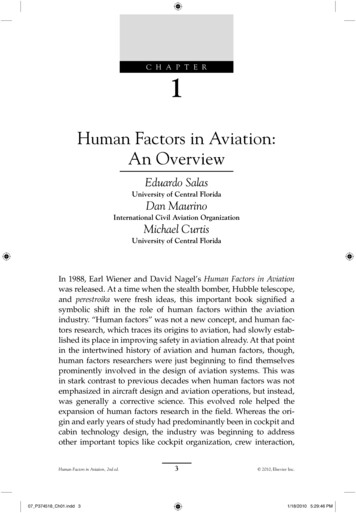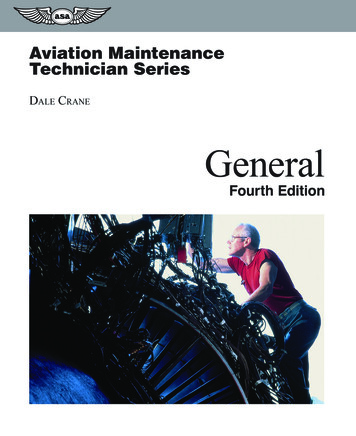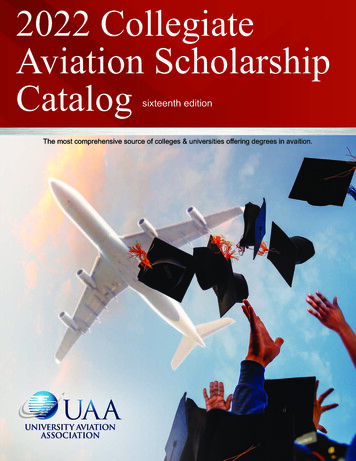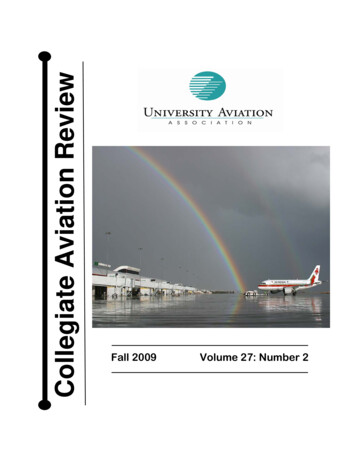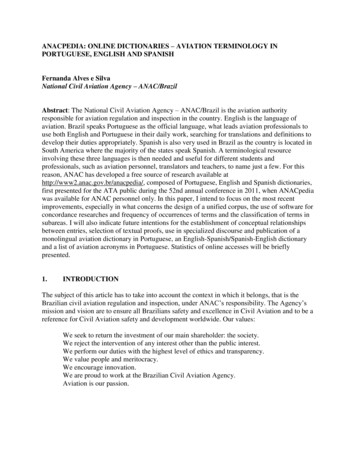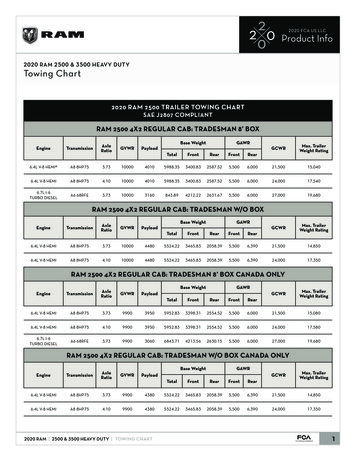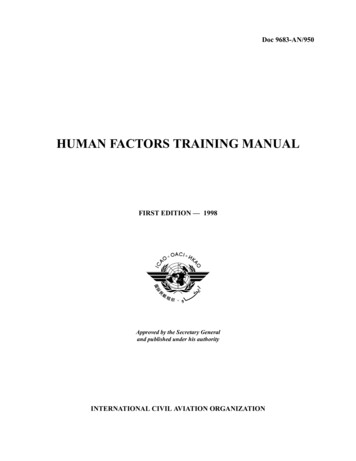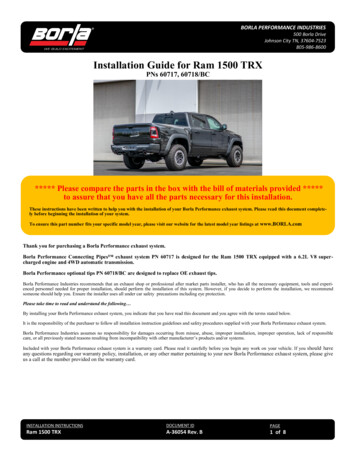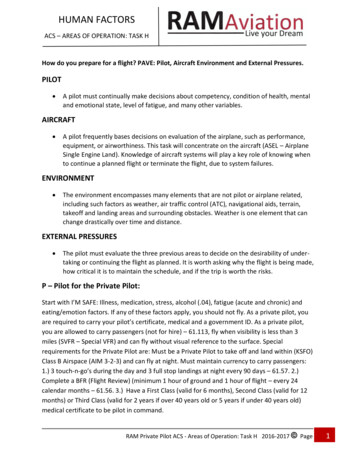
Transcription
HUMAN FACTORSACS – AREAS OF OPERATION: TASK HHow do you prepare for a flight? PAVE: Pilot, Aircraft Environment and External Pressures.PILOT A pilot must continually make decisions about competency, condition of health, mentaland emotional state, level of fatigue, and many other variables.AIRCRAFT A pilot frequently bases decisions on evaluation of the airplane, such as performance,equipment, or airworthiness. This task will concentrate on the aircraft (ASEL – AirplaneSingle Engine Land). Knowledge of aircraft systems will play a key role of knowing whento continue a planned flight or terminate the flight, due to system failures.ENVIRONMENT The environment encompasses many elements that are not pilot or airplane related,including such factors as weather, air traffic control (ATC), navigational aids, terrain,takeoff and landing areas and surrounding obstacles. Weather is one element that canchange drastically over time and distance.EXTERNAL PRESSURES The pilot must evaluate the three previous areas to decide on the desirability of undertaking or continuing the flight as planned. It is worth asking why the flight is being made,how critical it is to maintain the schedule, and if the trip is worth the risks.P – Pilot for the Private Pilot:Start with I’M SAFE: Illness, medication, stress, alcohol (.04), fatigue (acute and chronic) andeating/emotion factors. If any of these factors apply, you should not fly. As a private pilot, youare required to carry your pilot’s certificate, medical and a government ID. As a private pilot,you are allowed to carry passengers (not for hire) – 61.113, fly when visibility is less than 3miles (SVFR – Special VFR) and can fly without visual reference to the surface. Specialrequirements for the Private Pilot are: Must be a Private Pilot to take off and land within (KSFO)Class B Airspace (AIM 3-2-3) and can fly at night. Must maintain currency to carry passengers:1.) 3 touch-n-go’s during the day and 3 full stop landings at night every 90 days – 61.57. 2.)Complete a BFR (Flight Review) (minimum 1 hour of ground and 1 hour of flight – every 24calendar months – 61.56. 3.) Have a First Class (valid for 6 months), Second Class (valid for 12months) or Third Class (valid for 2 years if over 40 years old or 5 years if under 40 years old)medical certificate to be pilot in command.RAM Private Pilot ACS - Areas of Operation: Task H 2016-2017Page1
HUMAN FACTORSACS – AREAS OF OPERATION: TASK HA – Aircraft for the Private Pilot:Remember A R O W. Airworthiness Certificate (Has the aircraft had an Annual, 100 hour,Progressive - 91.409, Pitot Static/Transponder check (24 months - 91.411, 91.413), Aircraft hasthe required equipment – 91.205 if NOT Special Flight Permit 21.197 & 21.199, ELT check 91.207 and all AD’s have been complied - 91.403 39.3, Registration (Every Three Years) – 47.41,Operating Limits (Section 2 of POH, Pilot’s Operating Handbook) – 91.9 and Weight and Balance(Section 6 of POH). Fuel requirements for all flights (30 minutes Day, 45 minutes Night) 91.151. The required takeoff and landing distances, runway lengths and weather forecasts 91.103. Avionics familiarity, density altitude and a current sectional information.V – Environment for the Private Pilot:Think of the Airport and weather conditions: Crosswind, Takeoff and Landing distances, Ceilingconditions, visibility and your personal minimums. Plan on the weather for your Departure, Enroute and Destination. For example: Current Metar, TAF and FA (Area Forecast), surfaceanalysis chart, radar summary chart, winds and temperature aloft, significant weatherprognostic chart, convective outlook chart, Airmets and Sigmets, PIREPs, wind shear reports,icing and freezing levels and AWOS, ASOS and ATIS reports for the route and destination. Thepilot wants to make a competent “go/no-go” decision based on available weather information.Reference Weather Information – Task C in RAM Study Guide.E – External Pressures for the Private Pilot:Think about “Get there Itis.” The determination to reach a destination, combined withhazardous weather, claims the lives of dozens of pilots and their passengers yearly. Think aboutthe hazardous attitudes: Anti-authority, Impulsivity, Invulnerability, Macho and Resignation tosee if they may apply to this flight. Allowance for delays and diversions, alternative plans andpersonal equipment. After you use the PAVE checklist (step 1), use the CARE checklist(Consequences, Alternatives, Reality and External pressures) (step 2) and determine the leveland severity of the risk. (Step 3) perform the TEAM checklist. Transfer Risk, Eliminate Risk,Accept Risk and Mitigate Risk.RAM Private Pilot ACS - Areas of Operation: Task H 2016-2017Page2
HUMAN FACTORSACS – AREAS OF OPERATION: TASK HHypoxia is state of Oxygen deficiency, lack of partial pressure, on the body. Atcabin altitudes above 10,000 feet: judgment, memory, alertness, andcoordination can be impaired. Hypoxia can be suffered at altitudes as low as5,000 feet at night, due to the oxygen required for your rods in the eye.Symptoms: Tunnel Vision, A blue coloration of the fingernails and lips (Cyanosis),headaches, drowsiness, dizziness, and a sense of well-being (Euphoria).Causes:1. Hypoxic Hypoxia – Insufficient Partial Pressure of oxygen. Can occur atAltitudes above 10,000 feet depending on the health of the pilot.2. Hypemic Hypoxia – Total oxygen content of the blood is reduced. Carbonmonoxide from the exhaust or heavy smoking, inhibits the ability ofhemoglobin to release the oxygen bound to it and deliver oxygen to tissues.3. Histotoxic Hypoxia – Impaired Cellular Respiration. Small amounts ofalcohol and drugs, limit the amount of oxygen that the blood carries to thebody tissues.4. Stagnate Hypoxia – Restriction of Flow. Heart disease and G-forces restrictblood flow.Effects: The effects are quite difficult to recognize, especially when they occurgradually. The ability to take corrective actions is lost in 20 to 30 minutes at18,000 feet, followed by unconsciousness and death.Corrective Actions: Increase the concentration of oxygen or use supplementaloxygen if able and descend below 10,000 feet.RAM Private Pilot ACS - Areas of Operation: Task H 2016-2017Page3
HUMAN FACTORSACS – AREAS OF OPERATION: TASK HIs the state of breathing faster and/or deeper than necessary, bringing aboutlightheadedness associated with panic attacks. Hyperventilation reduces thecarbon dioxide concentration of the blood to below normal.Symptoms: Light headedness, drowsiness, tingling in the extremities, feelinganxious, yawing, chest pressure, headache, sweating, and vision changes.Causes: Stressful situations encountered during flight. (Cross-wind landings,Turbulent air, Weather, and Night Flying)Effects: Incapacitation can eventually result from in-coordination, disorientation,and painful muscle spasms. Unconsciousness and chest pain can occur.Corrective Actions: Control breathing in a paper bag, breathe through your nose,loosen your clothing, slow/open window and land as soon as possible.Once air (oxygen) is in your lungs, it is then exchanged for carbon dioxide. Carbon dioxide is a waste product of thecells that form your entire body. The oxygen moves into your blood and carbon dioxide moves out of your bloodinto your lungs. When you exhale, you are letting out all your carbon dioxide waste. This exchange takes place atthe alveoli.RAM Private Pilot ACS - Areas of Operation: Task H 2016-2017Page4
HUMAN FACTORSACS – AREAS OF OPERATION: TASK HMiddle Ear – During ascent, the expanding air in the middle ear pushes theEustachian tube open, and escapes down to the nasal passages. During a descent,the pilot must periodically open the Eustachian tube to equalize pressure.Sinus – During ascent and descent, air pressure in the sinuses equalizes thepressure through small openings that connect the sinuses to the nasal passages.ABSymptoms: Middle Ear (A) – Pressure can build up to a level that will hold theEustachian tube closed. Commonly referred to as, “Ear Block.”Symptoms: Sinus Problems (B) – Can occur in the frontal sinuses, located aboveeach eyebrow or upper cheek and produce excruciating pain.Causes: Flying with a cold, allergies, and respiratory infection.Effects: Middle Ear – Severe pain and hearing loss. Rupture of the ear drum canoccur in flight or after landing.Effects: Sinus Block – Usually on descents, can cause severe pain over the sinusarea and can make the upper teeth ache.Corrective Actions: Middle Ear–Swallowing, yawning and the Valsalva maneuver.Corrective Actions: Sinus Block – Do not fly with infections. Adequate protectionis usually not provided by decongestants, which may have side effects that canimpair pilot performance.RAM Private Pilot ACS - Areas of Operation: Task H 2016-2017Page5
HUMAN FACTORSACS – AREAS OF OPERATION: TASK HSpatial Disorientation is a condition in which the pilot’s perception of directiondoes not agree with reality. Spatial Disorientation from illusions can only beprevented by fixed points on the ground or by reference to the flight instruments.Symptoms: During flight, most of the senses are “fooled” by centrifugal force,and indicate to the brain that “down” is at the bottom of the cockpit no matterthe actual attitude of the aircraft. The inner ear contains semicircular canals,which contain fluid called “Endolymph” and small hairs called “Cilia” whichprovide information to the brain of pitch, roll, and yaw. Errors develop in thebrain’s estimate of rate and direction of turn in each axis.RAM Private Pilot ACS - Areas of Operation: Task H 2016-2017Page6
HUMAN FACTORSACS – AREAS OF OPERATION: TASK HCauses: Typically a temporary condition resulting from flight into poor weatherconditions with low or no visibility.Effects: Drift in the inner ear produce errors about the axes. Errors will build to apoint that control of the aircraft is lost, usually in a steep, diving turn known asgraveyard spiral. During the entire time, leading up to and well into the maneuverthe pilot remains unaware that the aircraft is turning, believing that they are instraight and level flight.Illusions in flightIllusions involving the semicircular canals of the vestibular system of the ear occurprimarily under conditions of unreliable or unavailable external visual referencesand result in false sensations of rotation. These include the leans, the graveyardspin and spiral, and the Coriolis illusion.RAM Private Pilot ACS - Areas of Operation: Task H 2016-2017Page7
HUMAN FACTORSACS – AREAS OF OPERATION: TASK HIllusions Leading to Landing ErrorsLanding errors from these illusions can be prevented by aerial visual inspectionsof unfamiliar airports, using the electronic glide slope, and maintaining optimumproficiency in landing procedures.1)2)3)4)5)Runway width Illusion:Terrain Illusion:Featureless Terrain:Atmospheric Illusions:Ground lighting Illusions:Corrective Actions: Illusions in Flight – Visual reference to reliable fixed points onthe ground and the Flight Instruments.Corrective Actions: Illusions leading to Landing Errors – Use the electronic glideslope when able. Red and White You’re Alright. White and White you’ll fly allnight. Red and Red Your Dead.RAM Private Pilot ACS - Areas of Operation: Task H 2016-2017Page8
HUMAN FACTORSACS – AREAS OF OPERATION: TASK HMotion sickness occurs when the central nervous system receives conflictingmessages from the body (including the inner ear, eyes, and muscles) affectingbalance and equilibrium.Symptoms: Dizziness, fatigue, cold sweating, headaches, and confusion are themost common symptoms.Causes: Fatigue, stress, anxiety, the use of alcohol, drugs, and medications.Effects: Airsickness is usually a combination of spatial disorientation, nausea andvomiting.Corrective Actions: Sit facing forward, focus on a point outside, Look out thewindow and gaze toward the horizon. Fresh, cool air and avoid foul odors.The Central Nervous SystemRAM Private Pilot ACS - Areas of Operation: Task H 2016-2017Page9
HUMAN FACTORSACS – AREAS OF OPERATION: TASK HCarbon Monoxide is a colorless, odorless, and tasteless gas contained in exhaustfumes. When breathed it reduces the ability of the blood to carry oxygen.Symptoms: Headaches, drowsiness, or dizziness, increasing blurred vision.Causes: Exhaust fumes escaping through shroud heaters or through manifoldcracks and seals.Effects: Carbon Monoxide is cumulative. Unconsciousness and eventual deathmay occur if you don’t remove yourself from the source.Corrective Actions: Turn off cabin heat, increase fresh air intake, open windows,use oxygen, land as soon as possible.Aircraft Contaminated Heater ShroudsRAM Private Pilot ACS - Areas of Operation: Task H 2016-2017Page10
HUMAN FACTORSACS – AREAS OF OPERATION: TASK HThe Body’s Stress ResponseWhen you perceive a threat, your nervous system responds byreleasing a flood of stress hormones, including adrenaline andcortisol. These hormones rouse the body for emergency action.Your heart pounds faster, muscles tighten, blood pressure rises,breath quickens, and your senses become sharper. These physicalchanges increase your strength and stamina, speed your reactiontime, and enhance your focus – preparing you to either fight or flee from thedanger at hand.Causes: Flying into deteriorating weather conditions, or trying to fly outsideyour comfort zone.Corrective Actions: Consider delaying or re-scheduling the flight.RAM Private Pilot ACS - Areas of Operation: Task H 2016-2017Page11
HUMAN FACTORSACS – AREAS OF OPERATION: TASK HFatigue is one of the most treacherous hazards to flight safety. Fatigue is bestdescribed as acute (short-term) or chronic (long-term).Symptoms: Acute – Is tiredness felt after periods of physical and mental strain.Symptoms: Chronic – Not enough time to recover between episodes of acutefatigue.Causes: Emotional pressure, mental strain, and lack of sleep.Effects: Acute – Coordination and alertness are reduced.Effects: Chronic – Performance continues to drop off, and judgment becomesimpaired so that unwarranted risks may be taken.Corrective Actions: Acute – Prevented by adequate rest and sleep, as well asexercise and proper nutrition.Corrective Actions: Chronic – Requires a prolonged period of rest or can betreated by a doctor.RAM Private Pilot ACS - Areas of Operation: Task H 2016-2017Page12
HUMAN FACTORSACS – AREAS OF OPERATION: TASK HA pilot or passenger who intends to fly after scuba diving should allow the body sufficient timeto rid itself of excess nitrogen absorbed during diving. If not, decompression sickness due toevolved gasses from our bodies own tissues, as a result of the increased pressure, can occurduring exposure to low altitude flying.Signs and symptoms of decompression sickness.TypeBubble LocationSigns & Symptoms (Clinical Manifestations) Mostly large joints of thebodyBends(elbows, shoulders, hip,wrists, knees, ankles) Localized deep pain, ranging from mild (a "tingle")to excruciating. Sometimes a dull ache, but rarely asharp pain.Active and passive motion of the joint aggravatesthe pain.The pain may be reduced by bending the joint tofind a more comfortable position.If caused by altitude, pain can occur immediatelyor up to many hours later.Causes: Leaving a high pressure environment, Ascent from depth, and Ascent toaltitude.Effects: Nitrogen bubbles expand and settle in the joints. The rate and duration of gas absorption under pressure. The deeper or longer the divethe more gas is absorbed into body tissue in higher concentrations than normal (Henry'sLaw).The rate and duration of outgassing on depressurization. The faster the ascent and theshorter the interval between dives the less time there is for absorbed gas to beoffloaded safely through the lungs, causing these gases to precipitate (come out ofsolution) and form "micro bubbles" in the blood.RAM Private Pilot ACS - Areas of Operation: Task H 2016-2017Page13
HUMAN FACTORSACS – AREAS OF OPERATION: TASK HCorrective Actions: For flights up to 8,000 feet: Wait at least 12 hours after diving (Nondecompression dive) or (Uncontrolled Ascent). For flight up to 8,000 feet: Wait at least 24 hours after diving (Decompression dive) or (Controlled Ascent). The waiting time before going to flight altitudes above 8,000 feet should beat least 24 hours. (AMSL – Aircraft mean sea level)A recompression chamber is a pressure vessel used to treat divers suffering fromcertain diving disorders such as decompression sickness.Often the terms recompression chamber, decompression chamber, hyperbaricchamber, and hyperbaric oxygen therapy chamber are used interchangeably.RAM Private Pilot ACS - Areas of Operation: Task H 2016-2017Page14
HUMAN FACTORSACS – AREAS OF OPERATION: TASK HThe retina is a layer at the back of the eye. Cells called rods and cones, convertlight energy to signals that are carried to the brain by the optic nerve. In themiddle of the retina is a small dimple called the fovea. It is the center of the eye’ssharpest vision.The fovea contains exclusively cones. The retina contains rods and cones. Thereare approximately 120 million rods and 6 million cones.RAM Private Pilot ACS - Areas of Operation: Task H 2016-2017Page15
HUMAN FACTORSACS – AREAS OF OPERATION: TASK H Cones: Very high resolution, used for color and distance. Day only. Rods: Very light sensitive, used for black and white vision. Day and Night.Rodopsium: Liquid produced at night to stimulate night vision. This is why ittakes 30-45 minutes to adjust to a low light situation.Iodopsium: Liquid produced during the day. If you turn off the lights, rodopsiumbegins to be produced (The white sparkles you see in your eyes).RAM Private Pilot ACS - Areas of Operation: Task H 2016-2017Page16
HUMAN FACTORSACS – AREAS OF OPERATION: TASK HA few hot weather causes of dehydration are hot cockpits and flight lines, wind,humidity, and diuretic drinks - coffee, tea, alcohol, and soft drinks-changes inclimatic conditions, sunburns, and improper attire for conditions.Some common signs of dehydration are headache, fatigue, cramps, sleepiness,and dizziness.Here, in checklist form, are the three stages of heat exhaustion. Transition fromthe one to the other can be very evident, hardly noticeable, or not evident at all.1. Heat stress (body temperature, 99.5-100 F) reduces Performance, dexterity, and coordination Ability to make quick decisions Alertness Visual capabilities Caution and caring2. Heat exhaustion (101-105 F) symptoms: Fatigue Nausea/vomiting Giddiness Cramps Rapid breathing Fainting3. Heat stroke ( 105 F) symptoms Body's heat control mechanism stops working Mental confusion Disorientation Bizarre behavior ComaPreventing dehydrationTo help prevent dehydration, you should drink two to four quarts of water every24 hours. Since each person is physiologically different, this is only a guide. Mostpeople are aware of the eight-glasses-a-day guide: If each glass of water is eightounces, then you end up with 64 ounces, which is two quarts.RAM Private Pilot ACS - Areas of Operation: Task H 2016-2017Page17
HUMAN FACTORSACS – AREAS OF OPERATION: TASK HAlcoholWhen alcohol is consumed, it is very rapidly absorbed into the blood and tissuesof the body but the process of detoxification is quite slow. The impairing effectsof alcohol are apparent quite soon after ingestion but it takes about 3 hours forthe effects of 1 ounce of alcohol to wear off. Nothing, inclusive of sleep, coffee orexercise, will speed up this process or minimize the effects of the alcohol.It has been recently determined that alcohol is absorbed into the fluid of theinner ear and will stay there after it has been eliminated from the blood, brainand body tissues. Since the inner ear affects balance, the presence of alcoholwithin the vestibular apparatus can lead to spatial disorientation and thepotential of vertigo.The presence of alcohol in the blood interferes with the normal absorption ofoxygen by the tissues and can result in histotoxic hypoxia. As the reduced cabinpressure at high altitudes has already reduced the ability of the hemoglobin toabsorb oxygen (Hypoxic Hypoxia), the effect of alcohol in the blood, during flightat high cabin altitudes, becomes much more pronounced than it would be at sealevel. The negative effects of one drink can be magnified as much as 2 to 3 timesdue to the cumulative effects of alcohol and altitude.Remember: Eight (8) hours bottle to throttle and .04% blood alcohol.RAM Private Pilot ACS - Areas of Operation: Task H 2016-2017Page18
HUMAN FACTORSACS – AREAS OF OPERATION: TASK HDrugs, and the condition or illness for which they are being taken, can negativelyimpact on pilot performance and efficiency and, as a consequence, can pose asignificant risk to safety of flight. Both prescription and non-prescription (overthe-counter) drugs can impair judgement and degrade coordination. Commonside effects of many non-prescription drugs, such as cold tablets, cough mixtures,antihistamines, appetite suppressors and laxatives, include drowsiness, confusion,blurred vision and dizziness. The effects of some of these drugs can be even morepronounced at altitude than they are on the ground. Drugs can also have acumulative effect and, if more than one drug is taken at the same time, thecombined negative effect may be well in excess of that of the individual drugs.Likewise, prescription drugs such as antibiotics or antidepressants can have apronounced effect on judgement, mental acuity and coordination. The advise of aqualified aviation medical practitioner should be sought to ensure that it is safe tofly during the course of a prescribed drug regimen. Obviously, the use of any illicitdrug is completely incompatible with flight safety. Antihistamines: Antihistamines are often taken to reduce the affects of anallergy or for a specific allergic reaction. They cause a level of sedation withvarying degrees (dependant upon both the drug and the individual) ofdrowsiness, degraded reaction time and disturbances of equilibrium andbalance. Sulfa Drugs: Sulfa drugs are antimicrobial drugs which inhibit the growth ofbacterial. They also cause an allergic reaction in a significant percentage ofthe population. Side effects of these drugs also can include visualdisturbances, dizziness, impaired reaction time, and depression. Tranquillizers: Tranquillizers affect reaction time, cause drowsiness,reduced concentration and division of attention. Motion Sickness Medications: Motion sickness remedies, in both oral andtopical format, can cause drowsiness and depress brain function. They canalso result in temporary deterioration in judgement and in decision makingskills.RAM Private Pilot ACS - Areas of Operation: Task H 2016-2017Page19
HUMAN FACTORSACS – AREAS OF OPERATION: TASK H Weight Loss Drugs: Appetite suppressing drugs inclusive of amphetaminescan cause feelings of well-being that can affect judgment. Barbiturates: Barbiturate, including phenobarbital can noticeably reducealertness.A Guide for Aviation Medical Examiners: Go to FAA.GOVPharmaceuticals (Therapeutic Medications) Do Not Issue - Do Not FlyThe information in this section is provided to advise Aviation Medical Examiners(AMEs) about two medication issues: Medications for which they should not issue applicants without clearancefrom the Federal Aviation Administration (FAA), ANDMedications for which for which they should advise airmen to not fly andprovide additional safety information to the applicant.IntroductionIn today's complex world of GPS, glass cockpits, and flight managementsystems, sometimes a simple rule of thumb or memory aid is still thebest way for a pilot to avoid an accident. After a lot of work, I thinkN.I.G.H.T. is one such flight planning aid pilots should use before everynight flight.Night flight has certain inherent risks. After a friend was killed in anighttime accident, I started reviewing all the information I could findrelating to night flying accidents, including various safetyrecommendations. In summarizing my research, I think the five mostimportant questions a pilot can ask or review before a night flight arecontained in the acronym N.I.G.H.T. Each letter asks a question orrelates to a topic that I think a pilot should consider before every nightflight.RAM Private Pilot ACS - Areas of Operation: Task H 2016-2017Page20
HUMAN FACTORSACS – AREAS OF OPERATION: TASK HThe five simple letters stand for five critical issues that addressimportant operational issues, potential hazards, or physical limitations topics unique to night flight.(N) NotamsWhen it comes to NOTAMs, you don't know what you don't know! Everyprudent pilot obtains a full briefing from a Flight Service Station or byusing a DUAT session to ensure they have all the information necessaryto conduct a safe flight. An important part of that briefing will beNOTAMs.But do you really know what you're getting . or not getting? Often, theanswer is "No!"NOTAMs are classified into three categories: NOTAM (D) or distantNOTAM (L) or local; andFlight Data Center (FDC) NOTAMs.If your flight is to a distant airport, the NOTAMs you receive typically willinclude information on navigational facilities, frequency changes, andregulatory amendments. But it will not include information contained inlocal NOTAMs. For instance, local NOTAMs include such information asrunway or taxiway closures and airport lighting outages. A total or partialoutage of a Visual Approach Slope Indicator (VASI) or Runway EndIdentifier Lights (REIL) system also will be reported as a local NOTAM.The only way to obtain a local NOTAM for your destination airport is tocall the FSS responsible (see Airport/Facility Directory) or to call theairport manager.(I) IllusionsMany different illusions can be experienced in flight; some can lead tospatial disorientation while others can lead to landing errors. IllusionsRAM Private Pilot ACS - Areas of Operation: Task H 2016-2017Page21
HUMAN FACTORSACS – AREAS OF OPERATION: TASK Hrank among the most common factors cited as contributing to fatalaccidents.Illusions Leading to Spatial DisorientationVarious complex motions and forces and certain visual scenesencountered in flight can create illusions of motion and position. Spatialdisorientation from these illusions can be prevented only by visualreference to reliable, fixed points on the ground or to flight instruments.For more information on the illusions such as: Coriolis illusionGraveyard spiralSomatogravic illusionFalse horizonAutokinesisElevator illusionInversion illusionRefer to Chapter 8 of the Aeronautical Information Manual (AIM).Illusions Leading to Landing ErrorsVarious surface features and atmospheric conditions encountered inlanding can create illusions of incorrect height above and distance fromthe runway threshold. Landing errors from these illusions can beprevented by anticipating them during approaches and by using anelectronic glide slope or VASI system when available. The most commonillusions leading to landing errors are: Runway width illusion. A narrower than usual runway can createthe illusion that the aircraft is at a higher altitude than it actuallyis. The pilot who does not recognize this illusion will likely fly alower approach, with the risk of striking objects along theapproach path or landing short. A wider than usual runway canRAM Private Pilot ACS - Areas of Operation: Task H 2016-2017Page22
HUMAN FACTORSACS – AREAS OF OPERATION: TASK Hhave the opposite effect, with the risk of overshooting therunway. Runway and terrain slopes illusion. An up-sloping runway, upsloping terrain, or both, can create the illusion that the aircraft isat a higher altitude than it is actually is. The pilot who does notrecognize this illusion will actually fly a lower than normalapproach. A down-sloping runway, down-sloping approachterrain, or both, can have the opposite effect. Featureless terrain illusion. An absence of ground features, aswhen landing over water, darkened areas, and terrain madefeatureless by snow, can create the illusion that the aircraft is at ahigher attitude than it actually is. The pilot who does notrecognize this illusion will fly a lower approach. Atmospheric illusions. Rain on the windscreen can create theillusion of greater height, and atmospheric haze can create theillusion of being at a greater distance from the runway. Ground lighting illusions. Bright runway and approach lightsystems, especially when few lights illuminate the surroundingterrain, may cause the illusion of less distance from the runway. Apilot who does not recognize this will fly a higher approach.Conversely, the pilot over-flying terrain which has few lights toprovide height cues may make a lower than normal approach.(G) GlideslopeCheck to see if a visual or electronic glide slope is available beforedeparting to your destination. Although visual glide slope indicators areinstalled at most airports, it is important to note that they may beinstalled at only one runway end. Also, there are many variations. Someof the not-so-common indicators include the Tricolor System, PulsatingSystem,Alignment of Element System, and the Three-bar VASI.RAM Private Pilot ACS - Areas of Operation: Task H 2016-2017Page23
HUMAN FACTORSACS – AREAS OF OPERATION: TASK H Tri-color System. Tri-color visual approach slope indicatorsnormally consist of a single light unit projecting a three-colorvisual approach path into the final approach area of the runwayupon which the indicator is installed. The below glide pathindication is red, the above glide path indication is amber, and theon glide path indicator is green. These types of indicators have auseful range of approximately one-half to one mile during the dayand up to five miles at night. Note: Since the tri-color VASI consistsof a single light source which could possibly be confused with otherlight sources, pilots should exercise care to properly locate andident
HUMAN FACTORS ACS – AREAS OF OPERATION: TASK H 3 Hypoxia is state of Oxygen deficiency, lack of partial pressure, on the body. At cabin altitudes above 10,000 feet: judgment, memory, alertness, and coordination can be impaired. Hypoxia can be suffered at altitudes as low as 5,000 feet at ni
